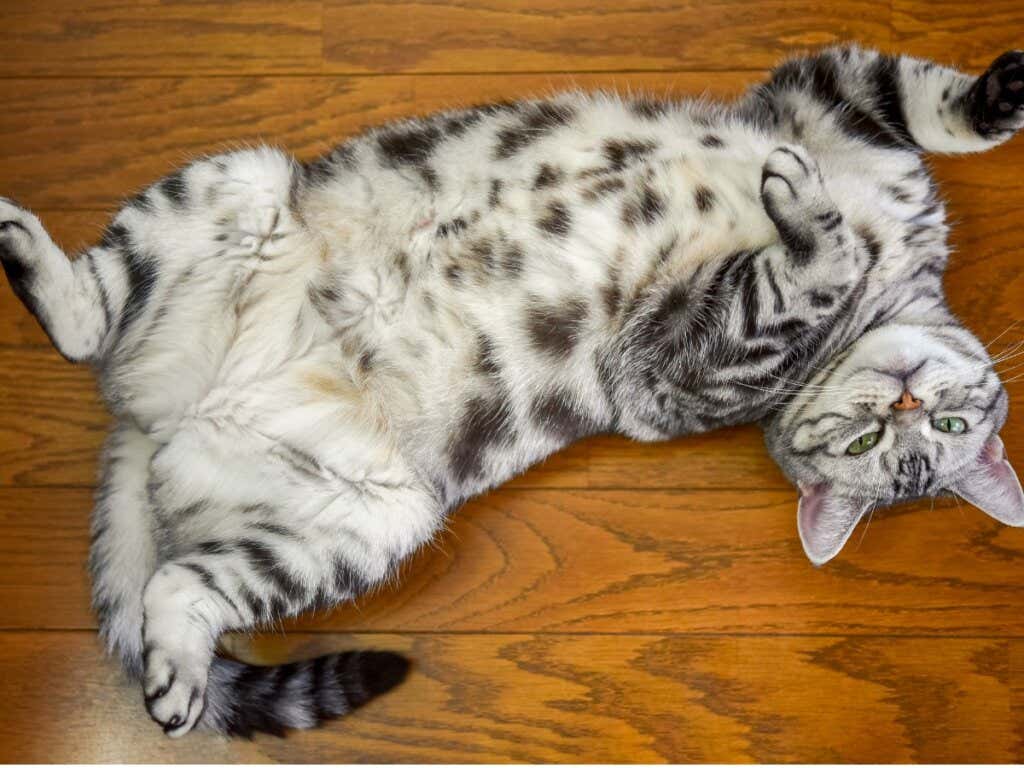What Is the Primordial Pouch in Cats?
If your feline has a skin of fur that wobbles when it walks, you may be observing the so-called primordial pouch in cats. There are some false beliefs and myths that need to be disproved here, in order not to make mistakes while caring for your pet.
This pouch has been associated with obesity, castration, and even theories linking their genes and their behavior. If your cat has a primordial pouch, then here’s all the information you need to know about it.
What is the primordial pouch in cats?
The primordial pouch is excess skin and fat that hangs between the cat’s hind legs. It usually appears in adulthood, although not in all cats, as it’s something that’s genetically encoded and is considered vestigial. This means that, at present, it has no clear physiological use.
The flaccidity of this pouch can lead you to think that the cat has been obese and they’ve since lost weight, leaving the hanging skin. However, it’s a normal part of the cat’s anatomy and doesn’t imply any lack of health.
In fact, big cats such as Bengal tigers or lions also have a primordial pouch.
What is this pouch for?
Like everything in nature, although it may not be useful now, at some point the primordial pouch made sense. Cats have been living with humans for thousands of years, and so this piece of their anatomy has been relegated to a vestige of their time as wild cats. However, it still seems to have some uses that contribute to a cat’s survival:
- Freedom of movement: The fur allows the cat to make movements with greater amplitude, especially when sneaking through narrow places or when stretching to climb to high places or run.
- Energy store: Being a fat store, experts think that this bag served as an energy repository in times of food shortage. On the other hand, when eating large amounts of prey in one sitting, experts believe that this piece of anatomy provided the cat with comfort to move while it had a full stomach.
- Protection: Catfights often involve teeth and claws, as well as trying to turn the opponent over. If a cat is attacked in the belly, the primordial pouch is a barrier to protect their vital organs.
Genetic predispositions
The primordial pouch is a genetic memento from times gone by. Today, except for mobility and protection from attack, it doesn’t serve any vital role in cat survival, as domestic felines rarely starve or hunt for survival. One proof of this is that not all of them have a primordial pouch.
Some cat breeds are more predisposed to have it – those that are genetically closer to their wild ancestors. The best known are the following:
- Bengal: This is a breed that arose from the crossing of a domestic cat and a Bengali wild cat, so ancient secondary characters prevail.
- Egyptian Mau: This is a direct descendant of the first domesticated cats of Egypt, where the desert climate made the species evolve to adapt to the scarcity of water and food – like a camel’s hump.
- Pixie Bob: This breed originated in the United States, where domestic cats were able to interbreed with wild cats that roamed farms.
- Japanese Bobtail: These cats were originally released in Japan in the last millennium to control rodent populations on silk farms. Later, they were adopted as pets.
There’s a belief that the presence of the primordial pouch in cats leads to genetics that are closer to their wild ancestors, which would also be reflected in their personality traits, making them more territorial and competitive. However, this hasn’t been scientifically proven.
Myths about the primordial pouch in cats
There are a number of explanations about this bag that can lead an owner to make decisions that negatively affect the cat’s well-being.
Does the primordial pouch in cats have to do with obesity?
The answer is no. It’s true that a primordial pouch can be mistaken for obesity. To distinguish them, here’s a trick: excess weight is evaluated by the contours of the cat. If, when looking at it from above you can see excess fat, then the cat is obese. Felines get fat across the board, so to speak.
Can it be removed?
Since this hanging fur doesn’t pose any risk to the health of your feline, resorting to surgery is not an option for veterinarians. Although aesthetically it takes away from their stylized appearance a bit, just think about how it can protect your feline from an attack. Exercise and diet won’t make it decrease in size.
Does it appear as a result of sterilization?
This isn’t true. When these two events occur, it’s usually due to the fact that the cat has been sterilized at an early age and the primordial pouch appears when it reaches adulthood. Although they coincide in some cases, they have nothing to do with each other.
The primordial pouch in cats can lead to poor decisions due to a lack of information that, in reality, is very simple to explain. Fortunately, modern-day knowledge, driven by the growing interest of the general public, in ensuring the well-being of their animal companions. And this, at the same time, is increasingly debunking more and more myths.
It might interest you...All cited sources were thoroughly reviewed by our team to ensure their quality, reliability, currency, and validity. The bibliography of this article was considered reliable and of academic or scientific accuracy.
- ¿Qué es la bolsa primordial? (2021). Laermfeuer. https://es.laermfeuer.org/bolsa-primordial-gatos-info-67983-2603
- Razas de gato- Todo sobre gatos. (2020, 13 julio). RAZASDEGATO.ORG. https://www.razasdegato.org/
- Overweight Dogs and Cats: Pet Obesity Risks. (2015). Best Friends Animal Society. https://resources.bestfriends.org/article/overweight-dogs-and-cats-pet-obesity-risks
- Ullmann, S. L. (1984). Early differentiation of the testis in the native cat, Dasyurus viverrinus (Marsupialia). Journal of anatomy, 138(Pt 4), 675.
